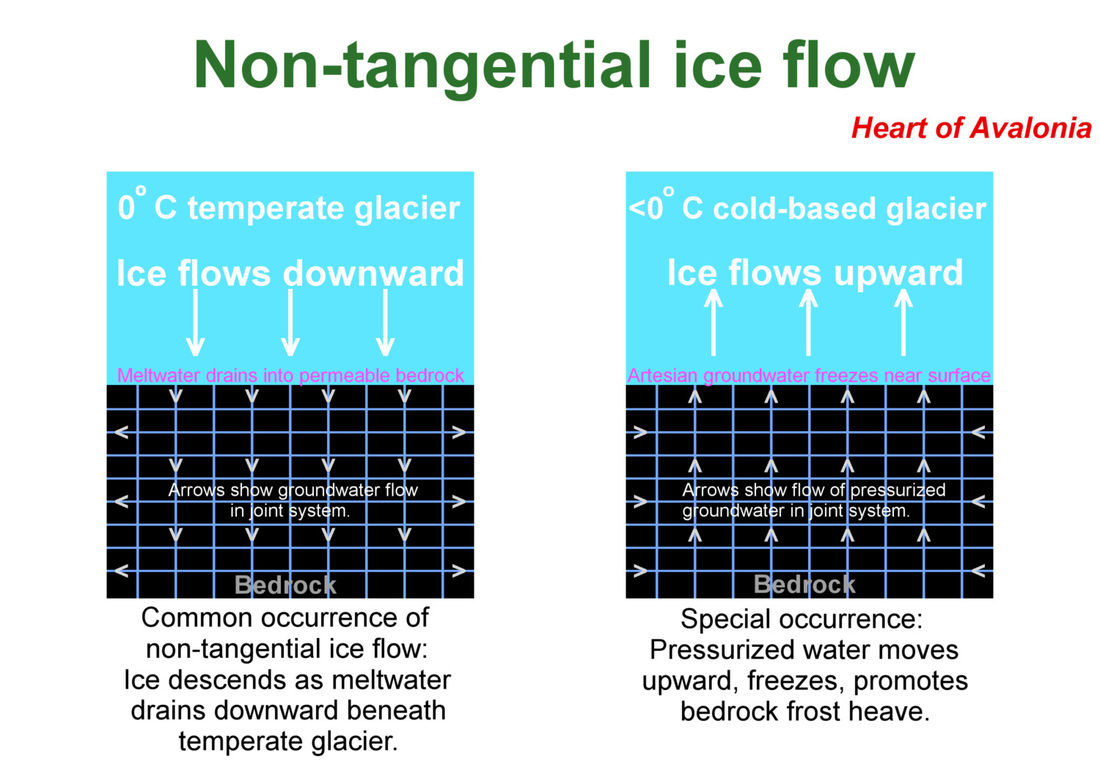| Heart of Avalonia |
Note-6 Non-tangential ice flow
This process may explain unusually severe and widespread bedrock frost heave in certain local areas.
In general, when a moving fluid interacts with a solid surface, the component of fluid velocity normal to the surface approaches zero at the surface. Fluid motion near the surface is thus tangential to the surface. Non-tangential flow near a surface can occur only when the surface is permeable to the fluid. Glacial ice moving over bedrock, either by creep or by basal slip, will move tangentially to the surface in most cases. However, as illustrated in the first panel of the above diagram, non-tangential ice motion can result when ice partially melts at a bedrock interface and the meltwater is able to drain downward through joints in the rock.
Another example of non-tangential ice motion is seen in plucking, where a portion of the ice bearing against an obstructing surface melts, enters joints or pores in the rock, and then re-emerges on the lee side of the obstruction. Non-tangential ice motion has little effect on a bedrock surface when the normal component of the ice velocity is directed toward the surface. However, when the normal component is directed away from the surface, rock is placed in tension and will usually fail, resulting in plucking or other related instances of disrupted bedrock.
The second panel of the above diagram shows a situation where pressurized groundwater bears against a layer of frozen bedrock overlain by cold glacial ice. In this case, water approaching the surface and freezing near the surface creates a component of ascending glacial ice motion. This type of environment could yield hydraulic bedrock frost heave as described in Note 5. The concept of glacial ice moving over an approximately horizontal bedrock surface, but moving non-tangentially with a significant ascending component may help explain areas that are especially densely populated with fissures, mounds and large bedrock frost heave features. In essence, glacial ice flowed upward from the surface, placing surface rocks in tension.
Another example of non-tangential ice motion is seen in plucking, where a portion of the ice bearing against an obstructing surface melts, enters joints or pores in the rock, and then re-emerges on the lee side of the obstruction. Non-tangential ice motion has little effect on a bedrock surface when the normal component of the ice velocity is directed toward the surface. However, when the normal component is directed away from the surface, rock is placed in tension and will usually fail, resulting in plucking or other related instances of disrupted bedrock.
The second panel of the above diagram shows a situation where pressurized groundwater bears against a layer of frozen bedrock overlain by cold glacial ice. In this case, water approaching the surface and freezing near the surface creates a component of ascending glacial ice motion. This type of environment could yield hydraulic bedrock frost heave as described in Note 5. The concept of glacial ice moving over an approximately horizontal bedrock surface, but moving non-tangentially with a significant ascending component may help explain areas that are especially densely populated with fissures, mounds and large bedrock frost heave features. In essence, glacial ice flowed upward from the surface, placing surface rocks in tension.
heartofavalonia.org Exploring Geologic History
